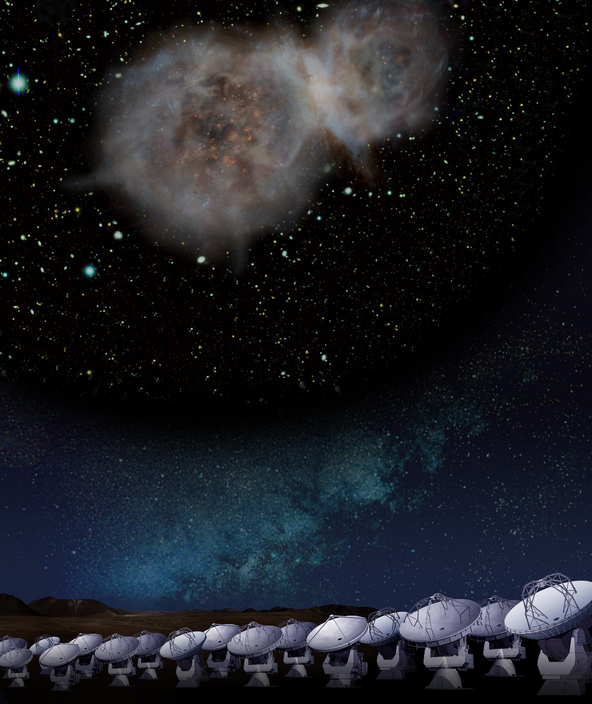This is definitely a story about a galaxy long ago and far away. An international team of researchers using the Atacama Large Millimeter/submillimeter Array (ALMA) has observed a “submillimeter galaxy” located about 12.4 billion light-years away. Their observations have revealed that the elemental composition of this galaxy in the early universe, at only 1.3 billion years after the Big Bang, was already close to the current elemental composition of the Universe. This means that intense star formation was taking place at that early point in the Universe’s history.
A submillimeter galaxy is a type of galaxy which has intense star formation activity and is covered by large amounts of dust. Since dust blocks observations in visible light, using ALMA’s millimeter wavelength capabilities can penetrate and see though dust clouds. In addition, ALMA also has extraordinary sensitivity, which is capable of catching even extremely faint radio signals. This is one of the most distant galaxies ALMA has ever observed.
The team was able to examine the chemical composition of the galaxy, called LESS J0332, and detected an emission line that contained nitrogen. To do this, they compared the brightness ratio of the observed emission lines from nitrogen and carbon with theoretical calculations. Their results showed that the elemental composition of LESS J0332, especially the abundance of nitrogen, is significantly different from that of the Universe immediately after the Big Bang – which consisted of almost only hydrogen and helium — but was much more similar to that of our Sun today, where a variety of elements exist abundantly.
It took 12.4 billion years for the emission lines from LESS J0332 to reach us, which means that the team was able to observe the galaxy located in the young universe at 1.3 billion years after the Big Bang.
“Submillimeter galaxies are thought to be relatively massive galaxies in the growth phase. Our research, revealing that LESS J0332 already has an elemental composition similar to the sun, shows us that the chemical evolution of these massive galaxies occurred rapidly made in the early universe, that is to say, in the early universe active star formation occurred for a short period of time,” said Tohru Nagao from Kyoto University, co-author of the paper.
The observations were made with ALMA, even though construction is not yet completed; only 18 antennas were used in this observation, while ALMA will be equipped with 66 antennas when completed.
This research was published in the “Letters” section of the journal, “Astronomy & Astrophysics.”
Lead image caption: Artist impression of the submillimeter galaxy LESS J0332 observed the ALMA at the 5000-meter altitude plateau. [Credit: NAOJ]
Source: ALMA


12.4 Light years or 12.4 billion light years?
Typo in title. You left out the “billion” in “12.4 billion light years”
Here’s the relevant (PDF) paper:
ALMA reveals a chemically evolved submillimeter galaxy at z=4.76.
Another edit .. “1.3 billion light years” (last line, 4th paragraph) makes no sense.
These data suggest the PopIII stars did a fair amount of fusion back then. Also there may have been a fair amount of fusion from subsequent PoPII stars.
At z = 4.76 this galaxy is at a distance given by the approximate de Sitter relationship
z = exp(Hd/c),
for H = 74km/s/Mpc and c = 3×10^5km/s. We may compute the distance with
(c/H)ln(z) = d = 4054Mpc ln(4.76)
which is equal to 2.06×10^{10}ly. The linear relationship v = Hd or z = Hd/c gives a distance 1.32×10^{10}ly for z = 1 and d = 8.95×10^{10}ly for z = 4.76. For z much larger than 1 z = v/c significant departures occur. As a result for high z redshifted galaxies one can’t as easily use years as a measure of light year distances.
LC
I looking back I thought I would comment on why this calculation gives 20.6 billion light year distance and the quoted distance is 12.6 billion light years. My calculation assmes the universe has been a de Sitter spacetime with a slow dark energy form of exponential expansion from the start. However, matter in the universe slowed expansion up until about 5 billion years ago. This gravity then prevented the universe from expanding as much as would otherwise be expected. To compute the actual number from theory is rather complicated.
LC
Why was my message deleted and
Stan Seibert’s message left in?
Maybe it’s because of your pseudonym – sneaky free advertising!
“submillimeter galaxy” located about 12.4 billion light-years
away.
12.4 x 10^9 years = 1.173102 x 10 ^28 cm. ( 1 light year =
9.4605x 10^17 cm).
Where, Pi^2 x Avogadro number x R = 1.08345^28 cm. this means
the “submillimeter
galaxy” is placed almost ½ of radius of the universe according my calculation.
Numerologists shouldn’t comment on science. The radius of the observable universe is ~ 46 billion light years, the radius of the future visible universe is ~ 62 billion light years, and the radius of the standard cosmology universe is infinite in the simplest topology.